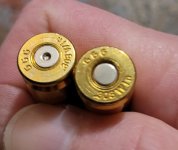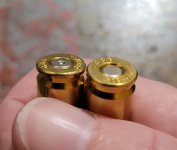Hi All,
I have been playing around with QL for months now and it's still a mystery on how to get reliable data. I see tons of people working exclusively with it so I guess it's something with my setup...
I'm handloading for a .308 win bolt action rifle, 26" barrel 1:12 using ramshot TAC (that's the only one I was able to source at the time) with Sierra HPBT 175 gr (#2275). Measured case capacity is 55 gr H2O, case length 50.95 mm, OAL 71.08 mm.
According to quickload, with 42.00 gr of TAC I should get speeds of 2532 fps. With 41.96 gr I measured 2647 fps (avg on 50 shots), 19 fps stdev. I tried different loads and it's always ~100 fps difference while I see on forums & youtube people talking about much better agreement.
Also, when I compare the Ramshot tables with QL it's a complete mess!
Manual v8 gives 2690 fps @ 43.2 gr, QL 2536 fps which is about the difference I measure in my shots. More troubling is that according to the manual, that load should give the max pressure while QL says we're fine by more than 15%! QL will let you go up to 45.5 gr to reach the pressure reported by the manual @ 43.2 gr.
It gets even worse with the Big Game: manuals says to load 180 gr Sierra SP with 50.3 gr for max pressure, QL says it's 20% above max. Same for the Sierra 200 gr bullets...
Am I missing something here? That's super scary to base a load on QL data because I may either start my minimal load close to the actual max load or, worse, be way underloaded thinking that I would get much more pressure at the end.
I have been playing around with QL for months now and it's still a mystery on how to get reliable data. I see tons of people working exclusively with it so I guess it's something with my setup...
I'm handloading for a .308 win bolt action rifle, 26" barrel 1:12 using ramshot TAC (that's the only one I was able to source at the time) with Sierra HPBT 175 gr (#2275). Measured case capacity is 55 gr H2O, case length 50.95 mm, OAL 71.08 mm.
According to quickload, with 42.00 gr of TAC I should get speeds of 2532 fps. With 41.96 gr I measured 2647 fps (avg on 50 shots), 19 fps stdev. I tried different loads and it's always ~100 fps difference while I see on forums & youtube people talking about much better agreement.
Also, when I compare the Ramshot tables with QL it's a complete mess!
Manual v8 gives 2690 fps @ 43.2 gr, QL 2536 fps which is about the difference I measure in my shots. More troubling is that according to the manual, that load should give the max pressure while QL says we're fine by more than 15%! QL will let you go up to 45.5 gr to reach the pressure reported by the manual @ 43.2 gr.
It gets even worse with the Big Game: manuals says to load 180 gr Sierra SP with 50.3 gr for max pressure, QL says it's 20% above max. Same for the Sierra 200 gr bullets...
Am I missing something here? That's super scary to base a load on QL data because I may either start my minimal load close to the actual max load or, worse, be way underloaded thinking that I would get much more pressure at the end.



